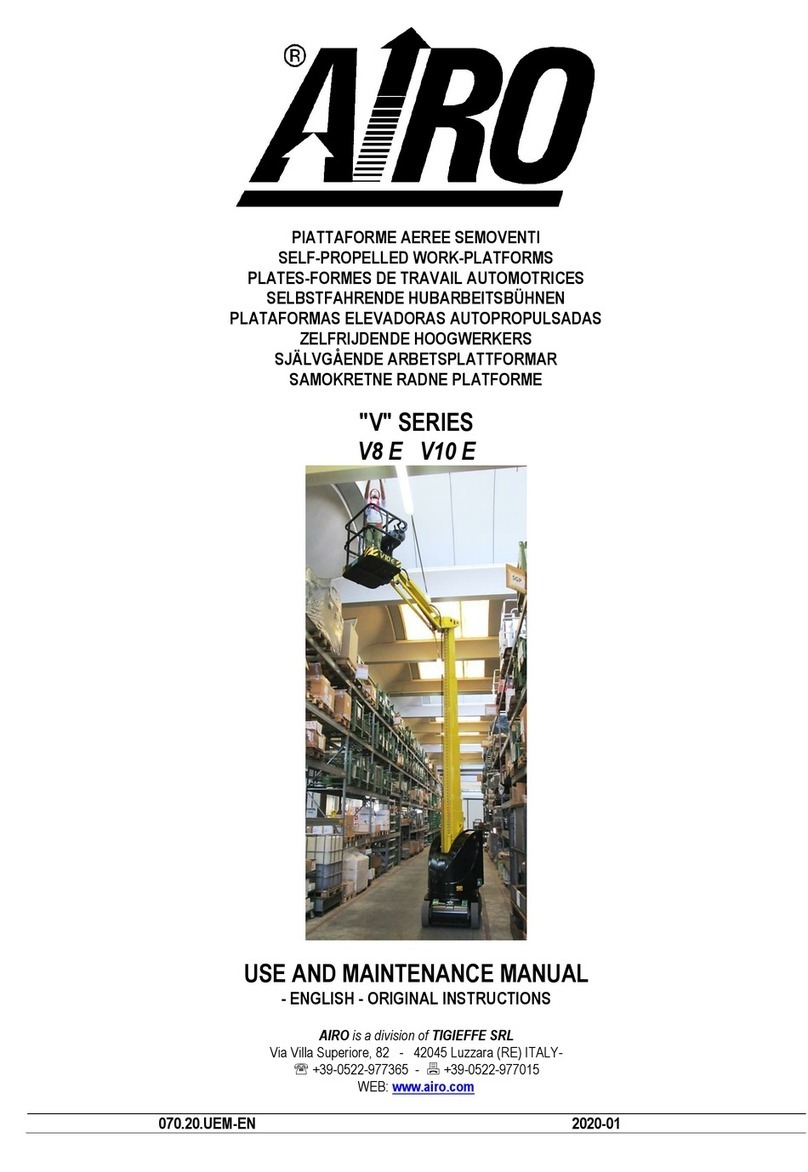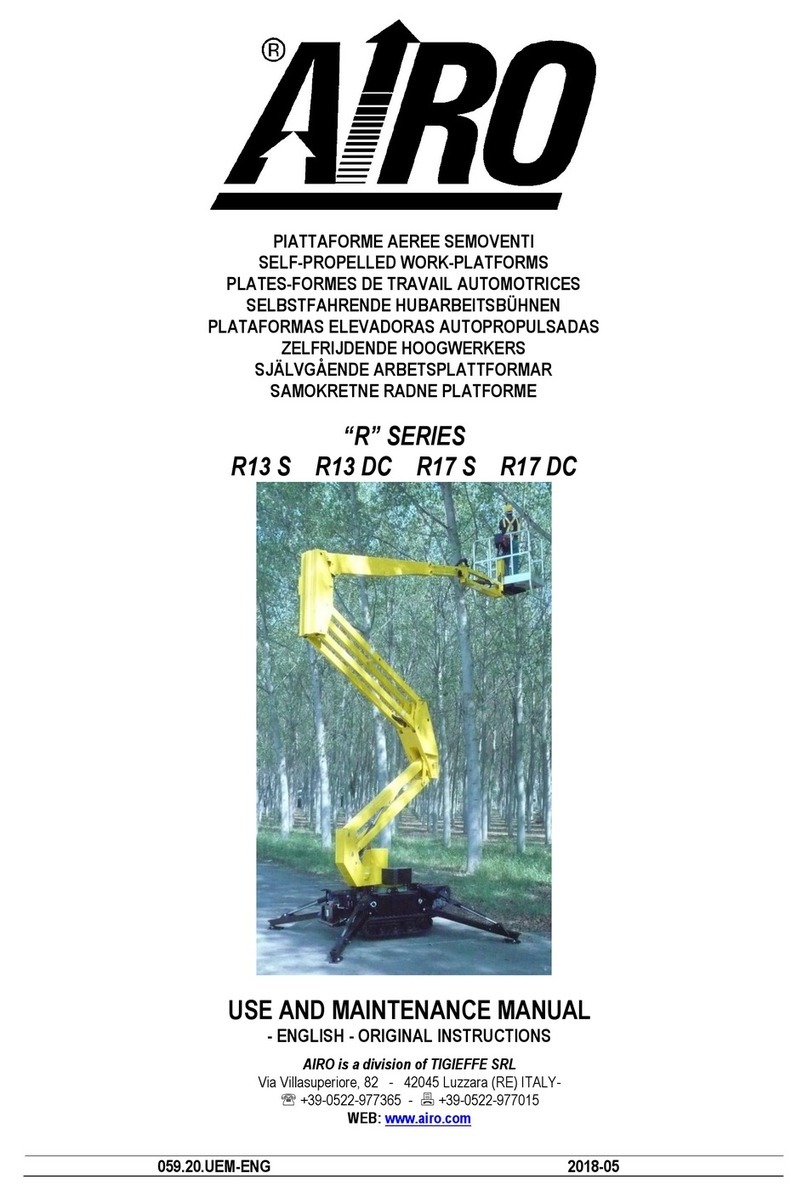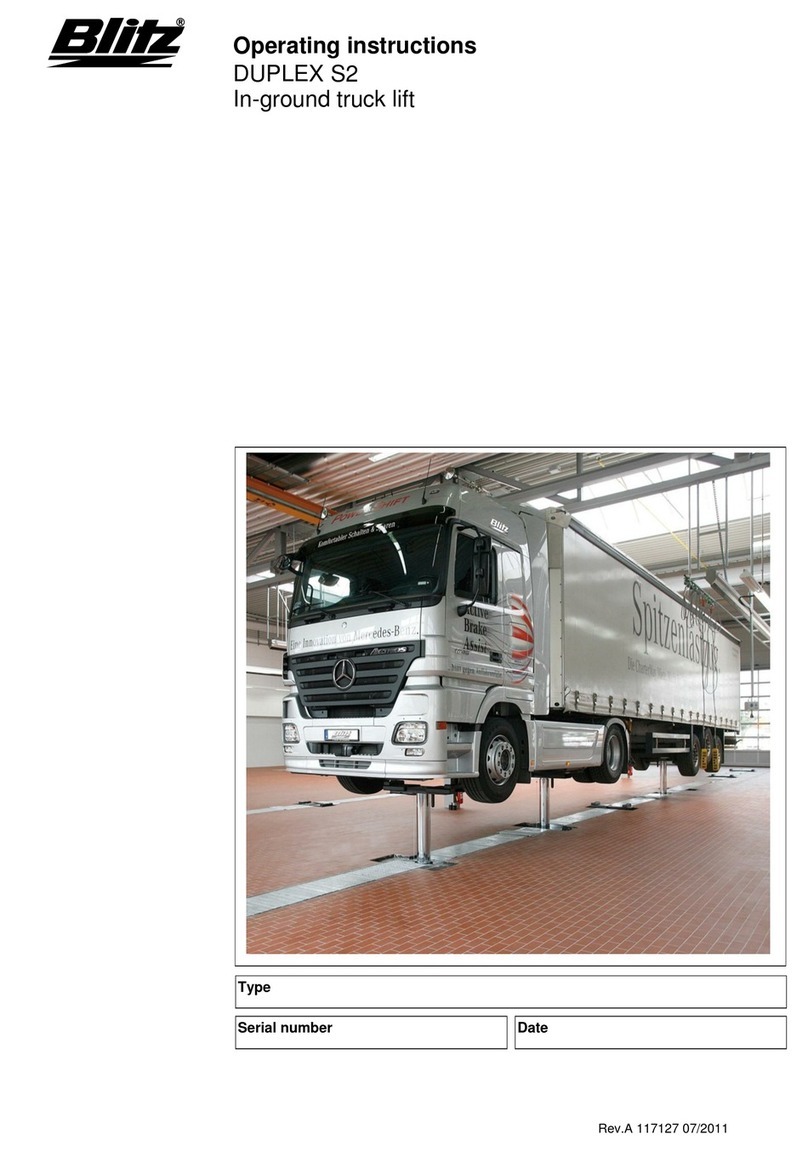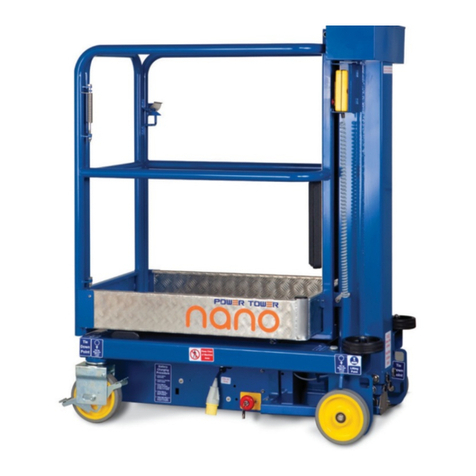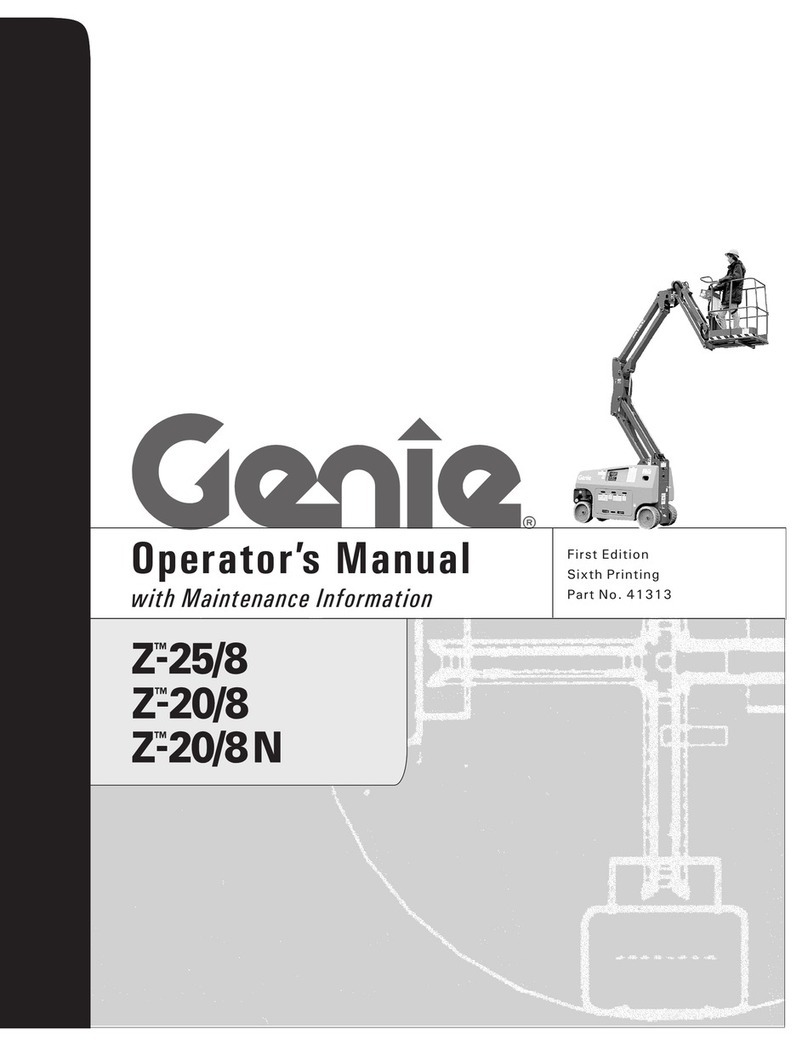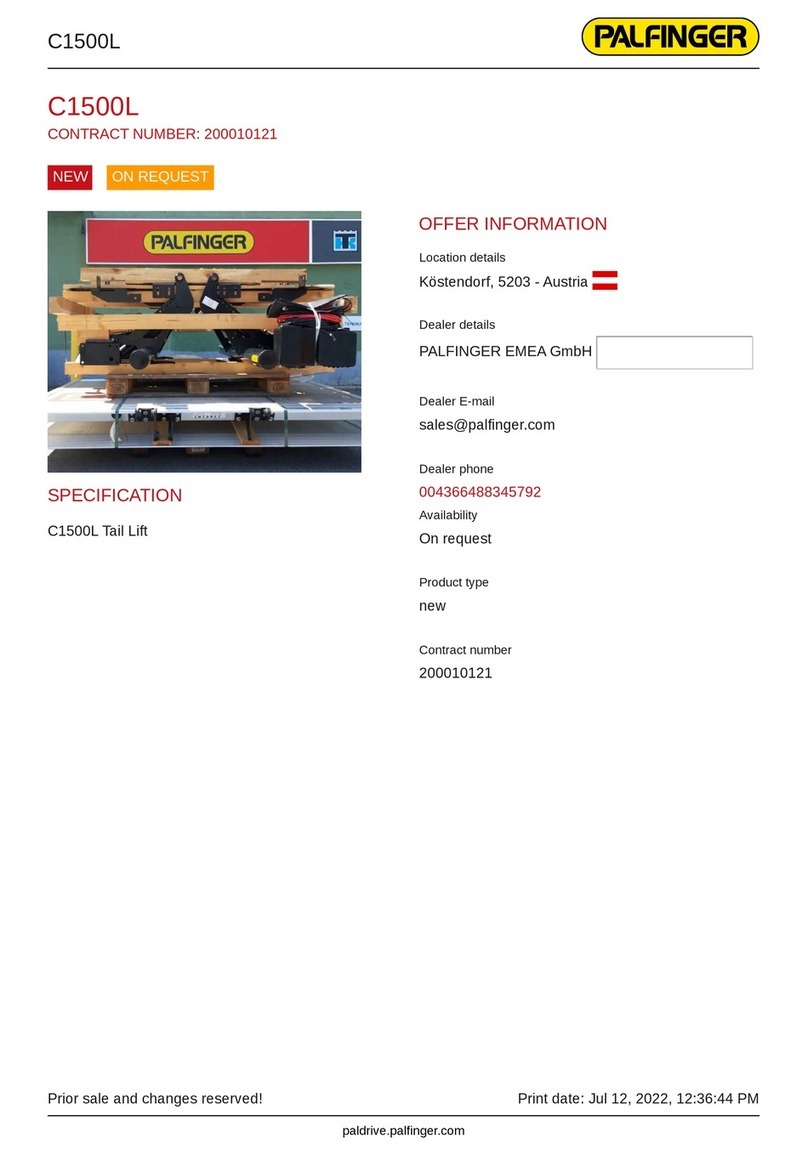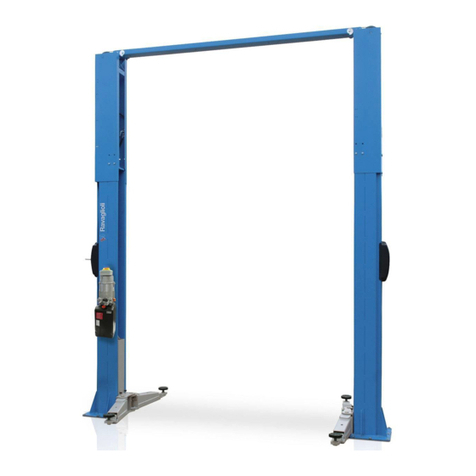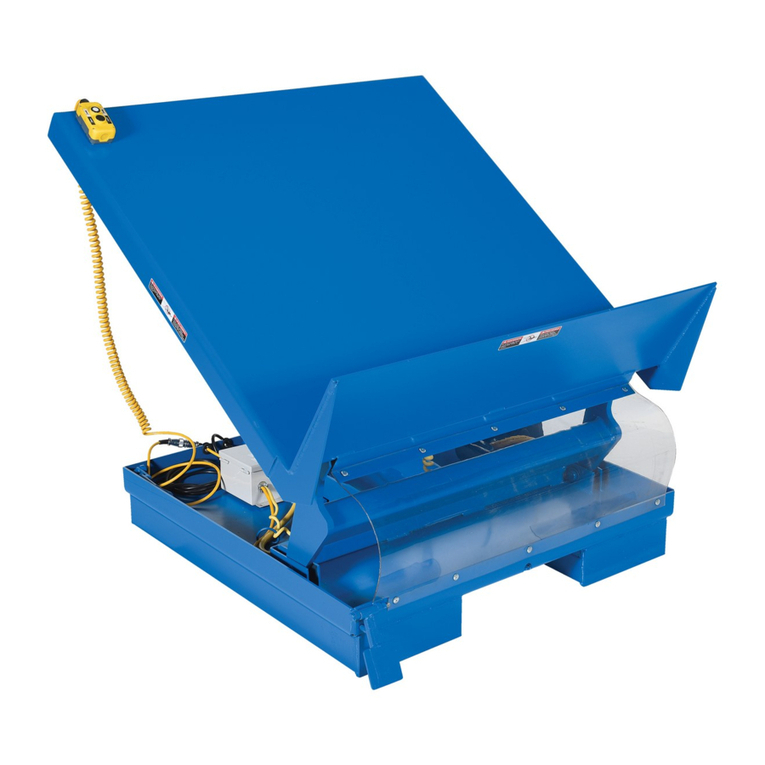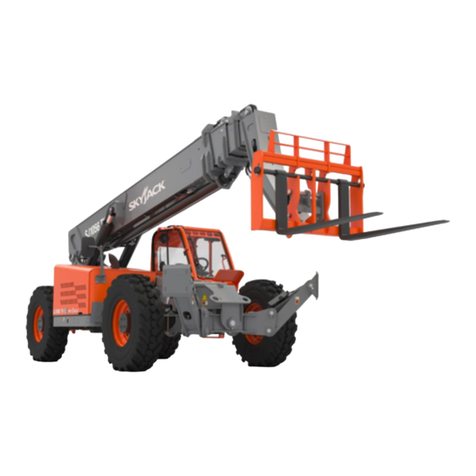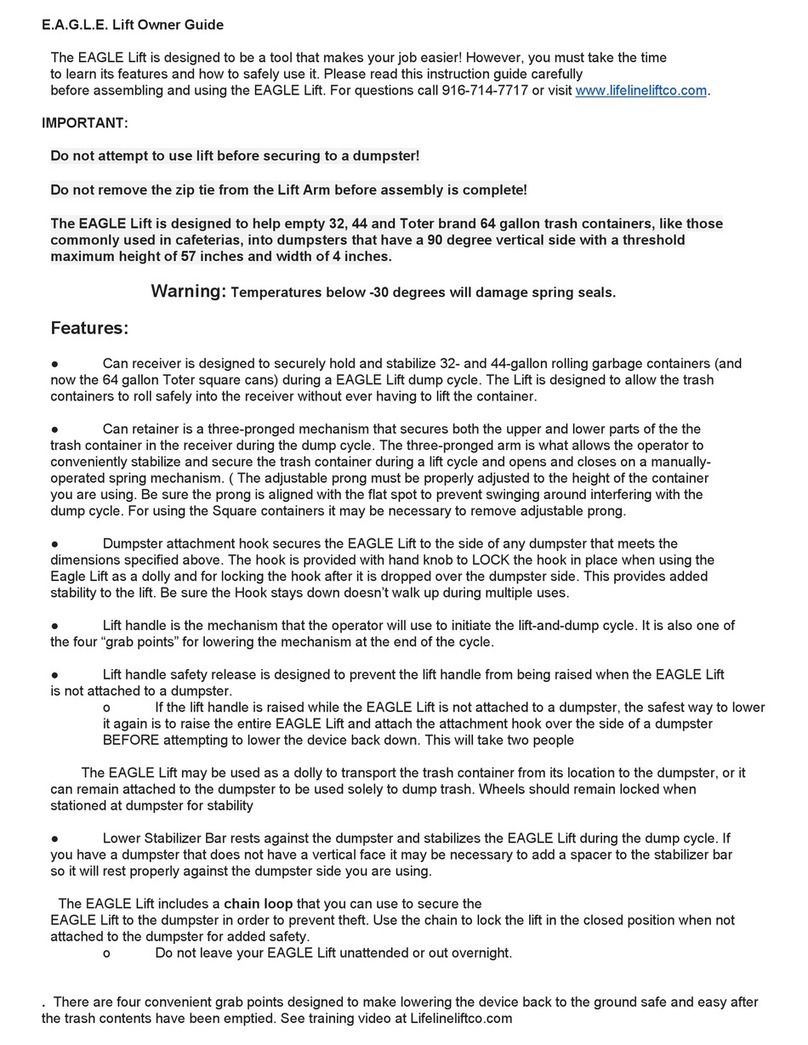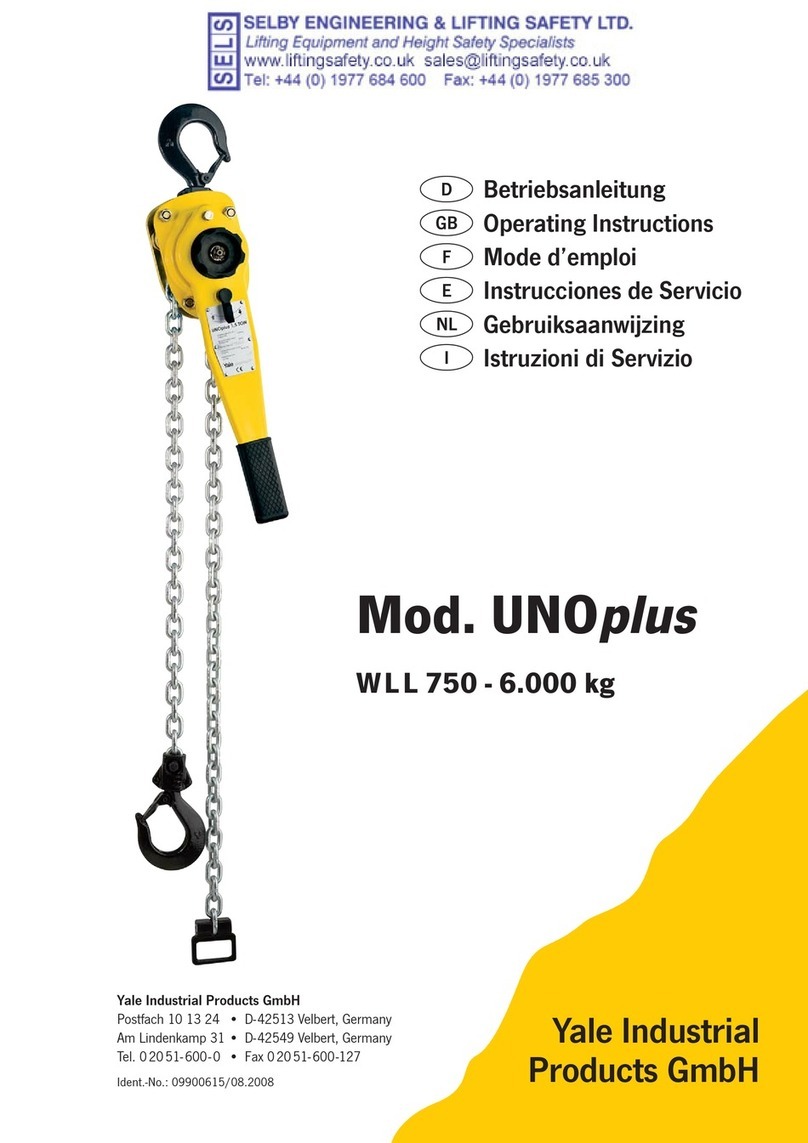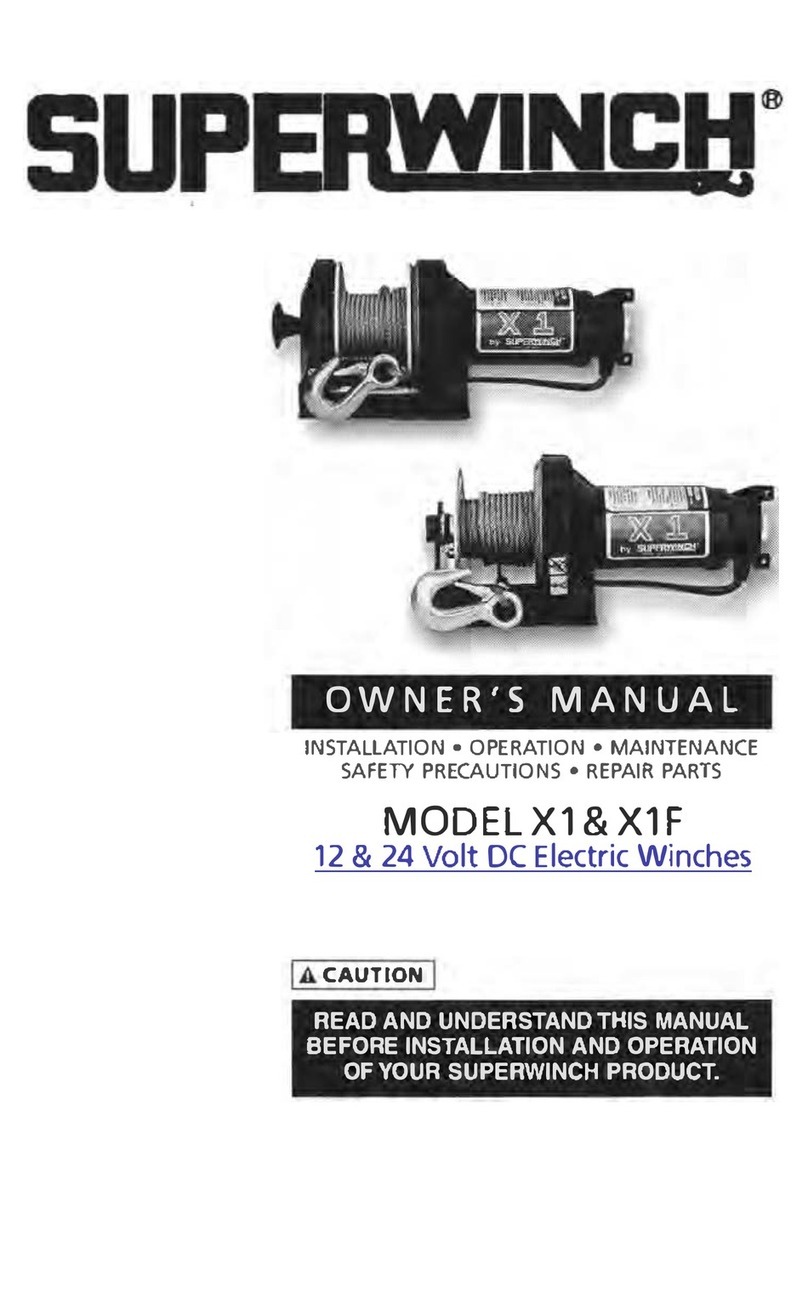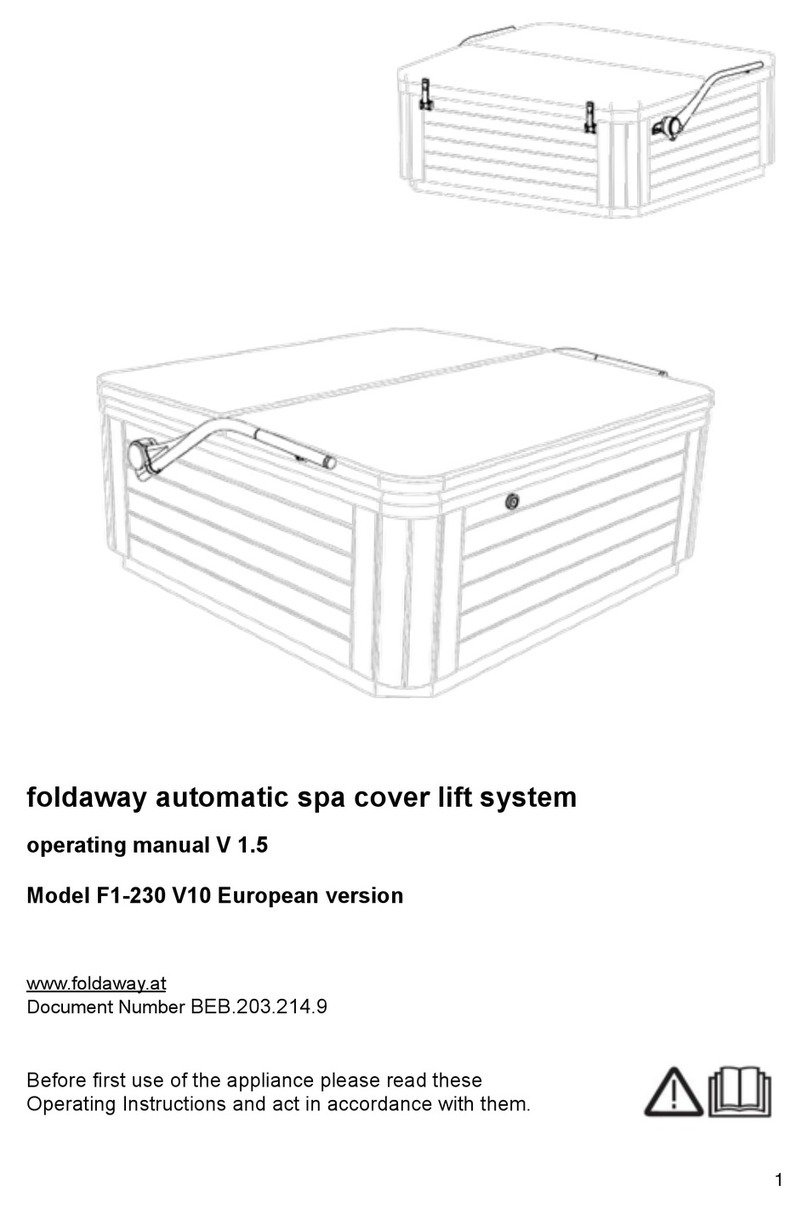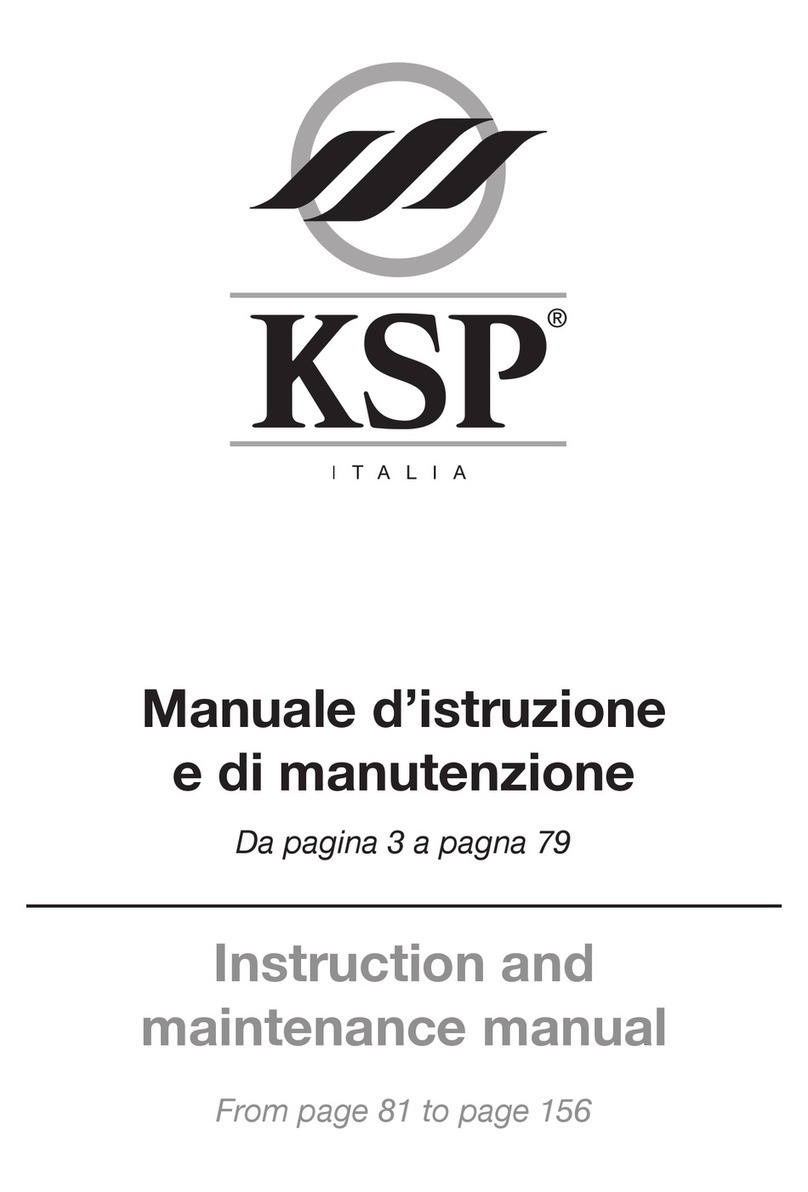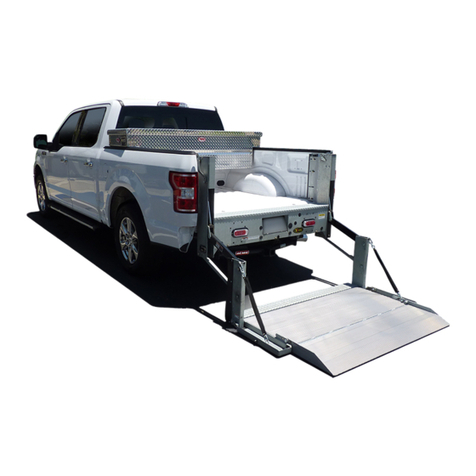TIGIEFFE AIRO A Series User manual

PIATTAFORME AEREE SEMOVENTI
SELF-PROPELLED WORK-PLATFORMS
PLATES-FORMES DE TRAVAIL AUTOMOTRICES
SELBSTFAHRENDE HUBARBEITSBÜHNEN
PLATAFORMAS ELEVADORAS AUTOPROPULSADAS
ZELFRIJDENDE HOOGWERKERS
SJÄLVGÅENDE ARBETSPLATTFORMAR
SAMOKRETNE RADNE PLATFORME
"A" SERIES
A16 J A18 J
USE AND MAINTENANCE MANUAL
- ENGLISH - ORIGINAL INSTRUCTIONS
AIRO is a division of TIGIEFFE SRL
Via Villa Superiore, 82 - 42045 Luzzara (RE) ITALY-
+39-0522-977365 - +39-0522-977015
WEB: www.airo.com
040.20.UEM-EN
2020-01

Use and Maintenance Manual –A16 J A18 J Series
Page 2
Revision date
Description of revision
2010-01
•Update due to new machine directive 2006/42/EC.
•Model names updated.
2010-11
•Biodegradable oil instructions introduced
•Temperatures and oil list updated.
2011-05
•Amended information on “Commissioning and first inspection, subsequent inspections
and title transfer report”.
•Inserted “Total quantity of battery electrolyte” in Technical Data (added optional batteries
in ED).
•Corrected "Max. power" diesel engine and inserted "Adjusted Power".
2011-08
•Changed the second part of the manual, with updated diagrams for 48V-12V converter
change in systems JE to JED.
2012-09
•Removed parking brakes in electric and electro-diesel versions: changed descriptions
and hydraulic diagram.
2013-10
•Specified instructions for harness anchoring points.
2014-09
•Inserted information on maximum limits of manual forces.
•Changed Name and Surname of CEO.
2015-01
•CE Conformity Declaration Updated.
•Hand Position Instructions Added.
2015-10
•Type of usable hydraulic oil updated.
•Added indication for spare parts. They must be original or approved by the manufacturer
of the machine in any way.
•Added "Leaving at height”.
•Updated operating system on the charger and overload in platform.
2017-01
•Added description of new overload controller.
2019-06
•Added “AIRO SENTINEL” secondary safety system description.
2019-07
•Updated procedure description of commissioning declaration in Italy.
2020-01
•Updated normative references and certifying body.

Use and Maintenance Manual –A16 J A18 J Series
Page 3
Tigieffe thanks you for purchasing a product of its range, and invites you to read this manual. Here you can find all the
necessary information for a correct use of the purchased machine; therefore, you are advised to follow the instructions carefully
and to read the manual thoroughly. The manual should be kept in a suitable place where no damage can occur to it. The
content of this manual may be modified without prior notice and further obligations in order to add changes and improvements
to the units already delivered. No reproduction or translation may take place without the written permission of the owner.
Contents:
1. INTRODUCTION................................................................................................................................................ 6
1.1. Legal aspects...................................................................................................................................................... 6
1.1.1. Delivery of the machine......................................................................................................................................... 6
1.1.2. Declaration of commissioning, first check, further periodical checks and transfers of ownership............................... 6
1.1.2.1. Declaration of commissioning and first check ......................................................................................................... 6
1.1.2.2. Further periodical checks....................................................................................................................................... 7
1.1.2.3. Transfers of ownership.......................................................................................................................................... 7
1.1.3. Operator training and information........................................................................................................................... 7
1.2. Tests performed before delivery......................................................................................................................... 7
1.3. Intended use........................................................................................................................................................ 7
1.3.1. Leaving at height................................................................................................................................................... 8
1.4. Description of the machine................................................................................................................................. 8
1.5. Control panels..................................................................................................................................................... 9
1.6. Power supply....................................................................................................................................................... 9
1.7. Machine life, demolition and decommissioning................................................................................................. 9
1.8. Identification ..................................................................................................................................................... 10
1.9. Location of main components.......................................................................................................................... 11
2. TECHNICAL FEATURES OF STANDARD MACHINES...............................................................................12
2.1. Model A16 JE..................................................................................................................................................... 12
2.2. Model A16 JED.................................................................................................................................................. 15
2.3. Model A16 JRTD................................................................................................................................................ 18
2.4. Model A18 JE..................................................................................................................................................... 21
2.5. Model A18 JED.................................................................................................................................................. 24
2.6. Model A18 JRTD................................................................................................................................................ 27
2.7. Vibrations and noise......................................................................................................................................... 30
3. SAFETY PRECAUTIONS................................................................................................................................31
3.1. Personal protective equipment (PPE)............................................................................................................... 31
3.2. General safety norms........................................................................................................................................ 31
3.3. Use instructions................................................................................................................................................ 32
3.3.1. General............................................................................................................................................................... 32
3.3.2. Handling ............................................................................................................................................................. 32
3.3.3. Operating procedures.......................................................................................................................................... 33
3.3.4. Wind speed according to Beaufort scale .............................................................................................................. 34
3.3.5. Pressure of the machine on ground and load-bearing capacity of ground.............................................................. 35
3.3.6. High-tension lines................................................................................................................................................ 36
3.4. Dangerous situations and/or accidents............................................................................................................ 36
4. INSTALLATION AND PRELIMINARY CHECKS........................................................................................... 37
4.1. Becoming acquainted with the machine........................................................................................................... 37
4.2. Preliminary operation checks........................................................................................................................... 37
5. USE INSTRUCTIONS......................................................................................................................................38
5.1. Platform control panel ...................................................................................................................................... 38
5.1.1. Drive and steering............................................................................................................................................... 40
5.1.2. Platform positioning movements.......................................................................................................................... 41
5.1.2.1. Pantograph (lower boom) lifting/lowering.............................................................................................................. 41
5.1.2.2. Upper boom lifting/lowering ................................................................................................................................. 41
5.1.2.3. Jib lifting/lowering................................................................................................................................................ 41
5.1.2.4. Telescopic boom extension/retraction .................................................................................................................. 42
5.1.2.5. Turret orientation (rotation).................................................................................................................................. 42

Use and Maintenance Manual –A16 J A18 J Series
Page 4
5.1.2.6. Platform rotation.................................................................................................................................................. 42
5.1.2.7. Platform levelling................................................................................................................................................. 42
5.1.3. Other functions of the platform control panel ........................................................................................................ 43
5.1.3.1. Selection of electric/thermic propulsion (OPTIONAL)............................................................................................ 43
5.1.3.2. Electrical pump start button 12V (Battery) or 230V/380V three-phase mains (power mains) - (OPTIONAL)............ 43
5.1.3.3. Heat engine start button (“ED”, “D” models) ......................................................................................................... 43
5.1.3.4. Manual horn........................................................................................................................................................ 43
5.1.3.5. Emergency stop.................................................................................................................................................. 43
5.1.3.6. Warning lights..................................................................................................................................................... 44
5.1.3.6.1 Enabled control panel green warning light (ZA) .................................................................................................... 44
5.1.3.6.2 Flat battery red warning light (ZB) –electric models only ...................................................................................... 44
5.1.3.6.3 Diesel engine fault / low fuel red warning light (ZC) .............................................................................................. 44
5.1.3.6.4 Danger red warning light (ZD).............................................................................................................................. 45
5.1.3.6.5 Overload red warning light (ZE) ........................................................................................................................... 45
5.1.4. “AIRO SENTINEL” Anti-Trapping System - OPTIONAL ........................................................................................ 46
5.1.4.1. SENTINEL control logic....................................................................................................................................... 47
5.2. Ground control panel (electric control unit)..................................................................................................... 48
5.2.1. On-off key and control panel selector (A) ............................................................................................................. 49
5.2.2. Emergency stop button (B).................................................................................................................................. 49
5.2.3. Diesel/electric drive power selector (C) ................................................................................................................ 49
5.2.4. Heat engine start button (D)................................................................................................................................. 49
5.2.5. User interface display (E) .................................................................................................................................... 50
5.2.6. Battery charger warning light (F).......................................................................................................................... 50
5.2.7. Enabled control panel warning light (G)................................................................................................................ 50
5.2.8. Diesel engine warning lights (H, L, M, N).............................................................................................................. 50
5.2.9. Levers of movement of the platform (O, P, Q, R, S, T, U) ..................................................................................... 50
5.3. Platform access................................................................................................................................................. 51
5.4. Machine start-up ............................................................................................................................................... 51
5.4.1. Diesel engine start-up ......................................................................................................................................... 52
5.4.2. Starting the 230V single-phase electric pump (OPTIONAL) .................................................................................. 53
5.4.3. Start-up of 380V three-phase work electrical pump (OPTIONAL).......................................................................... 54
5.4.4. Start-up of 12V emergency electrical pump (OPTIONAL for models “D”)............................................................... 55
5.5. Machine stop..................................................................................................................................................... 56
5.5.1. Normal stop ........................................................................................................................................................ 56
5.5.2. Emergency stop.................................................................................................................................................. 56
5.5.3. Diesel engine stop............................................................................................................................................... 56
5.5.4. Stopping the 380V three-phase or 230V single-phase electrical pump (optional)................................................... 56
5.6. Emergency manual controls............................................................................................................................. 57
5.7. Socket for electric tool connection (Optional).................................................................................................. 58
5.8. Fuel level and re-fuelling (models “ED”, “D”)................................................................................................... 58
5.9. End of work ....................................................................................................................................................... 58
6. HANDLING AND CARRYING.........................................................................................................................59
6.1. Handling............................................................................................................................................................ 59
6.2. Transportation................................................................................................................................................... 60
6.3. Emergency towing of the machine ................................................................................................................... 62
7. MAINTENANCE ...............................................................................................................................................63
7.1. Machine cleaning .............................................................................................................................................. 63
7.2. General maintenance........................................................................................................................................ 64
7.2.1. Various adjustments............................................................................................................................................ 65
7.2.2. Greasing............................................................................................................................................................. 66
7.2.3. Hydraulic circuit oil level check and change.......................................................................................................... 67
7.2.3.1 Biodegradable hydraulic oil (Optional).................................................................................................................. 68
7.2.3.2 Emptying ............................................................................................................................................................ 68
7.2.3.3 Filters ................................................................................................................................................................. 68
7.2.3.4 Washing ............................................................................................................................................................. 68
7.2.3.5 Filling.................................................................................................................................................................. 68
7.2.3.6 Commissioning / check........................................................................................................................................ 68
7.2.3.7 Mix ..................................................................................................................................................................... 69

Use and Maintenance Manual –A16 J A18 J Series
Page 5
7.2.3.8 Micro-filtration ..................................................................................................................................................... 69
7.2.3.9 Disposal.............................................................................................................................................................. 69
7.2.3.10 Topping up.......................................................................................................................................................... 69
7.2.4. Hydraulic filter replacement ................................................................................................................................. 70
7.2.4.1. Suction filters ...................................................................................................................................................... 70
7.2.4.2. Return filter......................................................................................................................................................... 70
7.2.5. Drive reduction gear oil level check and change................................................................................................... 71
7.2.5.1 Checks in the use of synthetic biodegradable oil in drive reduction gears.............................................................. 71
7.2.6. Air purging from oscillating axle locking cylinders ................................................................................................. 72
7.2.7. Telescopic boom sliding blocks clearance adjustment .......................................................................................... 73
7.2.8. Drive circuit pressure relief valve adjustment and operation check........................................................................ 74
7.2.9. Circuit movements pressure relief valve operation check...................................................................................... 75
7.2.10. Operation check and adjustment of the braking valves ......................................................................................... 76
7.2.11. Inclinometer operation check............................................................................................................................... 77
7.2.12. Operation check and adjustment of platform overload controller ........................................................................... 79
7.2.13. Overload controller by-pass –ONLY FOR EMERGENCY OPERATIONS ............................................................. 81
7.2.14. Operation check of M1 microswitches.................................................................................................................. 82
7.2.15. Dead-man pedal safety system operation check................................................................................................... 82
7.3. Starter battery ................................................................................................................................................... 83
7.3.1. Starter battery models “D” “ED” ........................................................................................................................... 83
7.3.2. Starter type battery for models “E” ....................................................................................................................... 83
7.3.3. Starter battery maintenance................................................................................................................................. 83
7.3.4. Starter battery recharge....................................................................................................................................... 83
7.4. “DRIVE” battery for models “E” and “ED” ....................................................................................................... 84
7.4.1. General instructions for DRIVE battery................................................................................................................. 84
7.4.2. DRIVE battery maintenance ................................................................................................................................ 84
7.4.3. DRIVE battery recharge ...................................................................................................................................... 85
7.4.4. Battery charger: fault report................................................................................................................................. 86
7.4.5. Battery replacement ............................................................................................................................................ 86
8. MARKS AND CERTIFICATIONS....................................................................................................................87
9. PLATES AND STICKERS...............................................................................................................................88
10. CHECK REGISTER .........................................................................................................................................90
11. ELECTRIC DIAGRAMS.................................................................................................................................107
12. HYDRAULIC DIAGRAM................................................................................................................................120
13. CE CERTIFICATES .......................................................................................................................................124

Use and Maintenance Manual –A16 J A18 J Series
Page 6
1. INTRODUCTION
This Use and Maintenance Manual provides general instructions concerning the complete range of machines indicated on the
cover. Therefore the description of their components, as well as control and safety systems, may include parts not present on
Your machine since supplied on request or not available. In order to keep pace with the technical development AIRO-Tigieffe
s.r.l. reserves the right to modify the product and/or the use and maintenance manual at any time without updating the units
already delivered.
1.1. Legal aspects
1.1.1. Delivery of the machine
Within EU (European Union) member countries the machine is delivered complete with:
▪Use and Maintenance manual in your language
▪CE mark applied on the machine
▪CE conformity declaration
▪Guarantee certificate
▪Declaration of internal testing
Only for Italy:
▪Instructions on commissioning declaration with INAIL and on the application for the first periodic check on the INAIL portal.
It is to be noted that the Use and Maintenance Manual is an integral part of the machine and a copy of this, together with copies
of the documents certifying that the periodical checks have been carried out, must be kept on board in its suitable container. In
the event of a transfer of ownership the machine must always be provided with its use and maintenance manual.
1.1.2. Declaration of commissioning, first check, further periodical checks and transfers of ownership
The legal obligations of the owner of the machine vary according to the country of commissioning. It is therefore recommended
to inquiry about the procedures in force in your country from the boards responsible for industrial safety. This manual contains a
final section called "Check register" for a better filing of documents and recording of any modifications.
1.1.2.1. Declaration of commissioning and first check
In ITALY the owner of the Aerial Platform must notify the use of the machine to the local competent INAIL and submit it to
periodical compulsory checks. The first of such checks is performed by the INAIL within sixty days from a request being made.
In the event of such time passing without the inspection being made, the employer can call in the ASL (Local Health Unit) or
qualified public or private services. Subsequent checks are made by the already-mentioned parties within thirty days from a
request being made. In the event of such time passing without these checks being made, the employer can call in qualified
public or private services. The checks are on a payment basis and the employer (machine owner) will be charged for them. For
these checks, the territorial inspection boards (ASL/USL or ARPA) and INAIL can be supported by qualified public or private
services. The qualified private institutes acquire the qualification of responsible for the public service and refer directly to the
public structure that controls this function.
For the commissioning declaration in Italy it is necessary to login to the INAIL portal. Follow the instructions delivered together
with other documents during the machine delivery, as well as the information about the portal.
The INAIL will assign a serial number and when the First Check is performed the “technical identification sheet” will be
completed indicating only the details obtained from the already-operating machine or from the instruction manual. Such
document shall form an integral part of the machine documentation.

Use and Maintenance Manual –A16 J A18 J Series
Page 7
1.1.2.2. Further periodical checks
Yearly checks are compulsory. In Italy the Aerial Platform owner must apply for a periodical check - by registered letter - to the
local competent inspection board (ASL/USL or other qualified public or private services) at least twenty days before the expiry
of the year from the last check.
NB: If a machine without a valid control document should be moved in an area outside the competence of the usual inspection
board, the owner of the machine must ask the inspection board, competent for the new territory where the machine is to be
used, for the annual check.
1.1.2.3. Transfers of ownership
In case of transfer of ownership (in Italy) the new owner of the Aerial Platform must notify the ownership of the machine to the
local competent inspection board (ASL/USL or ARPA or other qualified public or private services) by enclosing a copy of:
▪Declaration of conformity issued by the manufacturer.
▪Declaration of commissioning carried out by the first owner.
1.1.3. Operator training and information
The employer must ensure that the workers appointed to use the equipment are adequately and specifically trained so they are
able to use the Mobile Elevating Work Platform in a proper and safe way and also avoid the risks caused by other people.
1.2. Tests performed before delivery
Before being placed on the market, each MEWP undergoes the following tests:
▪Braking test
▪Overload test
▪Operating test
1.3. Intended use
The machine described in this use and maintenance manual is a self-propelled elevating work platform intended for lifting
persons and materials (equipment and work materials) in order to carry out maintenance, installation, cleaning, painting, de-
painting, sand-blasting, welding operations, etc.
The max. capacity allowed (which varies according to the model –see paragraph “Technical features”) is divided as follows:
▪80 Kg for each person on board.
▪40 Kg for equipment.
▪The remaining load is represented by the material being worked.
In any case NEVER exceed the maximum capacity allowed as indicated in paragraph "Technical features”. Persons, tools and
work materials can be loaded on the platform only from the access position (platform lowered). It is absolutely forbidden to load
persons, tools and work materials on the platform when it is not in access position.
All loads must be positioned inside the cage; do not lift loads (even if complying with the maximum capacity allowed) hanging
from the platform or from the lifting structure.
Do not carry large-sized panels since they increase the resistance to wind force thus causing the machine to overturn.
While the machine is being displaced with lifted platform, no horizontal loads can be loaded onto the platform (operators on
board are not allowed to pull wires or ropes, etc.).
An overload controller stops the operation of the machine if the load on the platform exceeds by 20% approx. the nominal load
(see chapter "General use rules”) and platform is lifted.
The machine cannot be used in areas where road vehicles operate. Always surround the working area by means of suitable
signs when the machine is used in public areas.
Do not use the machine to tow trucks or other vehicles.
All types of machine use other than those for which it was designed must be approved in writing by the machine manufacturer
following a specific request on the part of the user.

Use and Maintenance Manual –A16 J A18 J Series
Page 8
Do not use the machine for purposes other than those for which it was designed, except after making a
request and having obtained written permission in this sense from the manufacturer
1.3.1. Leaving at height
The mobile elevating work platforms are not designed by taking into account the risks of the “leaving at height” because the only
access position considered is when the platform is completely lowered. For this reason, this activity is formally forbidden.
However, there are exceptional conditions in which the operator needs to access or leave the work platform not in the access
position. This activity is normally defined as “leaving at height”.
The risks connected to the “leaving at height” do not depend exclusively on the PLE (work elevating platform) characteristics; a
specific risk analysis carried out by the employer can authorize this specific use by taking into account:
▪The working environment characteristics;
▪The absolute prohibition to consider the work platform as a fixing point for people working outdoors;
▪The use of the machine at xx% of its performances to avoid that additional forces created by a specific operation or
bending of the structure move away the access zone from the unloading zone. Provide for some tests in order to
define these limitations;
▪Provide for a specific evacuation procedure in case of emergency (for example: an operator always on the work
platform, one at the ground control panel while a third operator leaves the lifted platform);
▪Provide for a specific training of the staff both as operator and transported staff;
▪Equip the unloading zone with all the devices that are necessary to avoid the risk of fall of the staff that
accesses/leaves the platform.
What said above is not a formal authorization of the manufacturer for the “leaving at height”, but it wants to supply information to
the employer - who is fully responsible for that - which can be useful for the planning of this exceptional activity.
1.4. Description of the machine
The machine described in this use and maintenance manual is a mobile elevating work platform equipped with:
▪motorized chassis equipped with wheels;
▪hydraulically driven rotating turret;
▪Articulated boom operated by hydraulic cylinders (the number of articulations and cylinders varies according to
machine model).
▪operator platform (the max. capacity varies according to the model - see chapter "Technical features”).
The chassis is motorized to allow the machine to move even when the platform is lifted (see “Use instructions”). The machines
can be delivered with the following drive and steering features:
▪two driving wheels and two steering idle wheels;
▪Four driving wheels, of which two steering and two fixed.
Furthermore, to all the above combinations, it is possible to associate, optionally, a self-locking oscillating axle.
All wheels are equipped with hydraulic parking brakes, positive logic type (when drive controls are released brakes are
automatically activated).
The turret rests on a turntable fixed to the chassis and can be oriented (rotated) by 360° non-continuous around the central
axle of the machine by means of irreversible endless screw.
The lifting system, with articulated boom, can be divided into three main structures:
▪The first, with vertical extension, consists of a “double parallelogram” system named “pantograph”.
▪The second, consists of a lifting boom with telescopic extension.
▪The third, consists of the terminal boom named “Jib”.
Such lifting structures are driven by 4 double-acting hydraulic cylinders:
▪One cylinder for the “pantograph” extension.
▪One cylinder for the boom extension.
▪One cylinder for the extension/retraction of the telescopic boom.
▪One cylinder for the “jib” extension.

Use and Maintenance Manual –A16 J A18 J Series
Page 9
The hydraulic cylinders which move the articulated structure (except for the boom tilt sensor cylinder) are provided with over-
centre valves directly flanged on the same. These devices allow the booms to remain in position even if one of the supply tubes
accidentally breaks.
The platform, hinged to the end of the boom “jib”, can be rotated by 140° totally (70° on the right and 70° on the left) by means
of a rotary actuator fitted with over-centre valve. It is fitted with guardrails and toe boards of prescribed height (the guardrails
height 1100 mm; the toe boards height 150 mm). The platform levelling is automatic and is ensured by mechanical ties and
two cylinders in closed circuit. The manual level compensation is possible by acting on the relevant control only with completely
lowered booms (and with “Jib” inclination ranging between +10° and –70° with respect to the horizontal axis).
1.5. Control panels
The machine is equipped with two control panels:
▪on the platform for normal use of the machine.
▪On the turret (or on the ground) you can find the emergency controls to lower or stop the machine in emergency
situations, a key-selector to select the control panel and to start the machine.
1.6. Power supply
The machines can be powered by:
▪An electric-hydraulic system composed of rechargeable accumulators and electric pump.
▪A heat engine (Diesel engine models are identified by the abbreviation “D”; petrol engine models are identified by the
abbreviation “B”).
▪a dual-powered electric/thermic system (dual-powered Electric/Diesel models are identified by the abbreviation “ED”;
dual-powered Electric/Petrol models are identified by the abbreviation “EB”).
In any case both the hydraulic and the electric systems are equipped with all necessary protections (see wiring and hydraulic
circuit diagrams attached to this manual).
1.7. Machine life, demolition and decommissioning
The machine has been designed to last for 10 years in normal operating environments, if properly used and serviced. Within
this period, the manufacturer must carry out a complete inspection/overhaul.
If disposal of the unit is necessary, comply with current local regulations.
In Italy, the demolition/decommissioning must be notified to the local ASL / USL or ARPA.
The machine consists mainly of metal parts which are easy to be identified (steel for the most parts, and aluminium for the
hydraulic blocks); thus, we can state that the machine can be recycled at 90%.
European standards and those transposed by the member countries relating to respect for the
environment and the disposal of wastes envisage heavy administrative and penal fines in case of
infringement.
In case of demolition/decommissioning, carefully keep to the provisions of applicable regulations,
especially as regards materials such as hydraulic oil and batteries.

Use and Maintenance Manual –A16 J A18 J Series
Page 10
1.8. Identification
In order to identify the machine, when spare parts and service are required, always mention the information given in the serial
number plate. Should this plate (as well as the various stickers applied on the machine) be lost or illegible, it is to be replaced
as soon as possible. In order to identify the machine when no plate is available the serial number is also stamped on the
chassis. To locate the plate and the stamp of the serial number, see the following picture. It is recommended to copy such data
in the following boxes.
MODEL: ____________________
CHASSIS: ______________________
YEAR: __________________
Fig.1

Use and Maintenance Manual –A16 J A18 J Series
Page 11
1.9. Location of main components
The picture shows the machine and its own components.
Fig. 2
1) Control panel
2) Electric control unit
3) Hydraulic control unit
4) Hydraulic drive motors
5) Turret rotation hydraulic
motor
6) 230V plug (optional)
7) Spirit level (optional) for
visual check of machine
levelling
8) Lifting cylinders
9) Battery
10) Power assisted steering
11) Inclinometer
12) Heat engine fuel tank
13) Load limiter
14) Turntable
15) Control device for electric
system isolation (electric
machines “E” and
electro/diesel “ED” only).

Use and Maintenance Manual –A16 J A18 J Series
Page 12
2. TECHNICAL FEATURES OF STANDARD MACHINES
THE TECHNICAL FEATURES OF THE PRODUCTS IN THE FOLLOWING PAGES CAN BE MODIFIED
WITHOUT PRIOR NOTICE
2.1. Model A16 JE
A16 JE
Dimensions:
Maximum working height
16
m
Max. platform height
14
m
Ground clearance
290
mm
Max. outreach from turntable centre
8.1
m
Turret rotation (not continuous)
360
°
Platform rotation
140
°
Platform height for safety speed activation
< 3
m
Internal steering radius
1.15
m
External steering radius
3.6
m
Maximum capacity (m)
230
Kg
Max. number of people on the platform (n) –indoors
2
Tool and material weight (me) (**) –indoors
70
Kg
Max. number of people on the platform (n) –outdoors
2
Tool and material weight (me) ** –outdoors
70
Kg
Maximum drive height
Max
Maximum dimensions of platform
0.8 x 1.7
m
Max. hydraulic pressure
230
bar
Max. pressure of lifting circuit
230
bar
Min. pressure of braking circuit
50 ÷ 60
bar
Tyre dimensions (****)
Ø 730 x 230
mm
Tyre type (****)
250 - 15
Transport dimensions
5.5 x 1.765 x 1.985
m
Transport dimensions with retracted jib
N.A.
m
Machine weight (unloaded) (*)
7300
Kg
Stability limit:
Longitudinal slope
3
°
Transversal slope
3
°
Maximum wind speed (***)
12.5
m/s
Maximum manual force:
400
N
Max. load per wheel
3200
Kg
Performance:
Drive wheels
2
Max. drive speed
4
km/h
Safety drive speed
0.7
km/h
Oil tank capacity
104
Lt.
Gradeability
25
%
Max. operating temperature
+50
°C
Min. operating temperature
-15
°C

Use and Maintenance Manual –A16 J A18 J Series
Page 13
Battery power:
Battery capacity and voltage
2 x 24 / 450
V/Ah
Total electrolyte quantity
2 x 84
Lt.
Battery weight
2 x 400
Kg
Single-phase battery charger (HF)
48 / 45
V/A
Max. current absorbed by the battery charger
15
A
Max. installed power
9
kW
Electric pump power 1
4.5
kW
Max. absorbed current
160
A
Electric pump power 2
4.5
kW
Max. absorbed current
160
A
Electric pump power 3
NA
kW
Max. absorbed current
NA
A
Diesel drive power
Diesel engine type
NA
Motor power
NA
kW
Starter battery
NA
V/Ah
Diesel oil tank capacity
NA
Lt.
Max. drive speed
NA
km/h
380V three-phase electrical pump (optional)
Motor power
NA
kW
Max. absorbed current
NA
A
Max. drive speed
NA
km/h
230V single-phase electric pump (optional)
Motor power
NA
kW
Max. absorbed current
NA
A
Max. drive speed
NA
km/h
(*) In some cases different limits can be fixed. It is recommended to comply with the data shown on the machine plate.
(**) me = m –(n x 80)
(***) Wind speeds higher or equal to 12.5 m/s indicate that the machines can also be used outdoors; Wind speeds equal to 0 m/s indicate that the machines
can be used INDOORS ONLY.
(****) Standard Extra flexible tyres 250-15; Optional rough terrain tyres 10x16,5 filled with polyurethane foam; Optional rough terrain tyres 12x16,5 filled with
polyurethane foam.

Use and Maintenance Manual –A16 J A18 J Series
Page 14

Use and Maintenance Manual –A16 J A18 J Series
Page 15
2.2. Model A16 JED
A16 JED
Dimensions:
Maximum working height
16
m
Max. platform height
14
m
Ground clearance
290
mm
Max. outreach from turntable centre
8.1
m
Turret rotation (not continuous)
360
°
Platform rotation
140
°
Platform height for safety speed activation
< 3
m
Internal steering radius
1.15
m
External steering radius
3.6
m
Maximum capacity (m)
230
Kg
Max. number of people on the platform (n) –indoors
2
Tool and material weight (me) (**) –indoors
70
Kg
Max. number of people on the platform (n) –outdoors
2
Tool and material weight (me) ** –outdoors
70
Kg
Maximum drive height
Max
Maximum dimensions of platform
0.8 x 1.7
m
Max. hydraulic pressure
230
bar
Max. pressure of lifting circuit
230
bar
Min. pressure of braking circuit
50 ÷ 60
bar
Tyre dimensions (****)
Ø 730 x 230
mm
Tyre type (****)
250 - 15
Transport dimensions
5.5 x 1.765 x 1.985
m
Transport dimensions with retracted jib
N.A.
m
Machine weight (unloaded) (*)
7600
Kg
Stability limit:
Longitudinal slope
3
°
Transversal slope
3
°
Maximum wind speed (***)
12.5
m/s
Maximum manual force:
400
N
Max. load per wheel
3200
Kg
Performance:
Drive wheels
2
Max. drive speed
4
km/h
Safety drive speed
0.7
km/h
Oil tank capacity
104
Lt.
Gradeability
25
%
Max. operating temperature
+50
°C
Min. operating temperature
-15
°C
Battery power:
Standard battery capacity and voltage
2 x 24 / 350
V/Ah
Total electrolyte quantity of standard battery
2 x 70
Lt.
Standard battery weight
2 x 350
Kg
Optional battery capacity and voltage
2 x 24 / 420
V/Ah
Total electrolyte quantity of optional battery
2 x 95
Lt.
Optional battery weight
2 x 355
Kg
Single-phase battery charger (HF)
48 / 45
V/A
Max. current absorbed by the battery charger
15
A
Max. installed power
9
kW
Electric pump power 1
4.5
kW
Max. absorbed current
160
A
Electric pump power 2
4.5
kW
Max. absorbed current
160
A
Electric pump power 3
NA
kW
Max. absorbed current
NA
A

Use and Maintenance Manual –A16 J A18 J Series
Page 16
Diesel drive power
Diesel engine type
HATZ 1D81C
Max. motor power
9.6
kW
Adjusted Power
9.6
kW
Starter battery
12 / 132
V/Ah
Total electrolyte quantity
7
Lt.
Diesel oil tank capacity
20
Lt.
Max. drive speed
4
km/h
380V three-phase electrical pump (optional)
Motor power
NA
kW
Max. absorbed current
NA
A
Max. drive speed
NA
km/h
230V single-phase electric pump (optional)
Motor power
NA
kW
Max. absorbed current
NA
A
Max. drive speed
NA
km/h
(*) In some cases different limits can be fixed. It is recommended to comply with the data shown on the machine plate.
(**) me = m –(n x 80)
(***) Wind speeds higher or equal to 12.5 m/s indicate that the machines can also be used outdoors; Wind speeds equal to 0 m/s indicate that the machines
can be used INDOORS ONLY.
(****) Standard Extra flexible tyres 250-15; Optional rough terrain tyres 10x16,5 filled with polyurethane foam; Optional rough terrain tyres 12x16,5 filled with
polyurethane foam.

Use and Maintenance Manual –A16 J A18 J Series
Page 17

Use and Maintenance Manual –A16 J A18 J Series
Page 18
2.3. Model A16 JRTD
A16 JRTD
Dimensions:
Maximum working height
16
m
Max. platform height
14
m
Ground clearance
350
mm
Max. outreach from turntable centre
8.1
m
Turret rotation (not continuous)
360
°
Platform rotation
140
°
Platform height for safety speed activation
< 3
m
Internal steering radius
1.15
m
External steering radius
3.6
m
Maximum capacity (m)
230
Kg
Max. number of people on the platform (n) –indoors
2
Tool and material weight (me) (**) –indoors
70
Kg
Max. number of people on the platform (n) –outdoors
2
Tool and material weight (me) ** –outdoors
70
Kg
Maximum drive height
Max
Maximum dimensions of platform
0.8 x 1.7
m
Max. hydraulic pressure
230
bar
Max. pressure of lifting circuit
230
bar
Min. pressure of braking circuit
50 ÷ 60
bar
Tyre dimensions
Ø 800 x 320
mm
Type of tyres
12 x 16.5
Transport dimensions
5.5 x 2 x 2.05
m
Transport dimensions with retracted jib
N.A.
m
Machine weight (unloaded) (*)
7160
Kg
Stability limit:
Longitudinal slope
4
°
Transversal slope
4
°
Maximum wind speed (***)
12.5
m/s
Maximum manual force:
400
N
Max. load per wheel
3200
Kg
Performance:
Drive wheels
4
Max. drive speed
4.7
km/h
Safety drive speed
0.7
km/h
Oil tank capacity
104
Lt.
Gradeability
40
%
Max. operating temperature
+50
°C
Min. operating temperature
-15
°C
Battery power:
Battery capacity and voltage
NA
V/Ah
Battery weight
NA
Kg
Single-phase battery charger (HF)
NA
V/A
Max. current absorbed by the battery charger
NA
A
Max. installed power
NA
kW
Electric pump power 1
NA
kW
Max. absorbed current
NA
A
Electric pump power 2
NA
kW
Max. absorbed current
NA
A
Electric pump power 3
NA
kW
Max. absorbed current
NA
A

Use and Maintenance Manual –A16 J A18 J Series
Page 19
Diesel Power HATZ
Diesel engine type
HATZ 3L41C
Max. motor power
38.8
kW
Adjusted Power
35.5
kW
Starter battery
12 / 132
V/Ah
Total electrolyte quantity
7
Lt.
Diesel oil tank capacity
45
Lt.
Diesel Power ISUZU
Diesel engine type
ISUZU 4LE1
Max. motor power
39
kW
Adjusted Power
35
kW
Starter battery
12 / 132
V/Ah
Total electrolyte quantity
7
Lt.
Diesel oil tank capacity
45
Lt.
380V three-phase electrical pump (optional)
Motor power
NA
kW
Max. absorbed current
NA
A
Max. drive speed
NA
km/h
230V single-phase electric pump (optional)
Motor power
2.2
kW
Max. absorbed current
13.9
A
Max. drive speed
NA
km/h
(*) In some cases different limits can be fixed. It is recommended to comply with the data shown on the machine plate.
(**) me = m –(n x 80)
(***) Wind speeds higher or equal to 12.5 m/s indicate that the machines can also be used outdoors; Wind speeds equal to 0 m/s indicate that the machines
can be used INDOORS ONLY.

Use and Maintenance Manual –A16 J A18 J Series
Page 20
Other manuals for AIRO A Series
3
This manual suits for next models
8
Table of contents
Other TIGIEFFE Lifting System manuals
